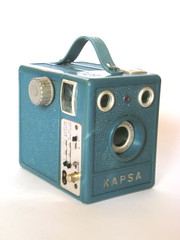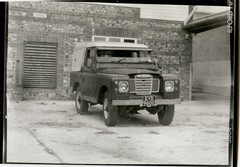Difference between revisions of "Kapsa"
(different "all rights reserved" photo substituted from Flickrer; layout) |
(swapped problem photo for different CW pool image) |
||
| Line 10: | Line 10: | ||
{|class=floatright | {|class=floatright | ||
| | | | ||
| − | {{ | + | {{Flickr_image |
| − | | image_source=http://www.flickr.com/photos/ | + | |image_source= http://www.flickr.com/photos/sdamelio/5565941524/in/pool-camerawiki |
| − | | image=http:// | + | |image= http://farm6.static.flickr.com/5104/5565941524_12fb0c31f8_m.jpg |
| − | | image_align=center | + | |image_align= center |
| − | | image_text= | + | |image_text= |
| − | |image_by= | + | |image_by= Damélio |
| − | |image_rights= | + | |image_rights= wp |
}} | }} | ||
|- | |- | ||
Revision as of 02:06, 3 June 2011

|
| image by Luciano Lazzarotto |
| ||
|
Kapsa is a Bakelite (and later other plastic) 120 or 620 film 6x9cm/6x4cm box camera made in Sao Paolo, Brazil by D. F. Vasconcellos (DFV)[1]. It was introduced in the early 1950s. There was a hinged mask for conversion to 6x4cm frames. The 110mm Vascromat lens has two auxiliary lenses giving three focus distances; 1-2 metres, 2-8 metres, and 8 metres-infinity. The camera is fitted with a single-leaf leaf shutter with a speed of 1/100 second and B, with three aperture sizes, f22, f16, and f11. On one side it has a metal panel with all the controls except the film advance knob. Of course it has the two brilliant viewfinders which are typical for box cameras.
It was considered a budget camera in comparison to more advanced cameras of the time due to its limited focusing abilities.
Sources/links
- "Brazil's Secret Camera"
- Kapsa image on flickr by galessa's plastics
- Kapsa group on flickr
Notes

|
| image by Nibelunga O^O (Image rights) |

